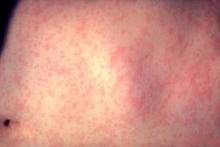BOSTON – By mid-October, 2011 was already the worst year for measles cases in the U.S. since 1996.
But with 214 U.S. measles cases identified by the Centers for Disease Control and Prevention as of Oct. 14, the 2011 case number still remains very modest and allows America to remain a country where measles has been "eliminated," its status since 2000, Huong McLean, Ph.D., said at the annual meeting of the Infectious Diseases Society of America.
For measles to be considered no longer eliminated from the United States, person-to-person transmission of the virus would need to persist in the country for a year, said Dr. McLean, an epidemiologist in the National Center for Immunization and Respiratory Diseases of the CDC in Atlanta.
"We’ve been getting a lot of imported cases, but the spread has been very limited," she said in an interview. "As long as there is measles elsewhere in the world, [the United States] is going to get importations."
The CDC attributed a third of the U.S. cases this year to direct importations, roughly similar to the 47% average importation rate each year over the past decade, she reported. Other world locations have a much greater measles burden. The CDC traced about half of the 2011 importations into the European Union, which this year has so far reported more than 28,000 measles cases, half of them in France.
The majority of U.S. measles cases this year were in children aged 19 years or younger, with 20% of the national total in infants aged 6-15 months. However, adult cases accounted for 41% of the 2011 caseload, and within that subgroup the largest number occurred in young adults aged 20-39, who had 27% of the total U.S. measles cases this year.
Among the 214 U.S. cases, 187 were in U.S. residents, and 180 cases (84%) occurred in people who had either been previously unvaccinated for measles or had an unknown vaccine status. The total also included 19 people (9%) who had previously received just one measles vaccine dose (the CDC recommends that people receive two doses to better insure immune coverage), and 15 (7%) with evidence of having received two doses, Dr. McLean said.
This year included 16 U.S. measles outbreaks, the highest number in more than a decade. The outbreaks, defined as at least three linked cases, accounted for half of the 2011 U.S. measles cases, with a median of 5.5 patients in each outbreak.
The largest U.S. 2011 outbreak as of mid-October, in the Minneapolis area, typifies a common outbreak scenario. According to a report at the meeting from the Minnesota Department of Health, an unvaccinated, U.S.-born 2-year old child traveled to Kenya. Back home in Hennepin County, Minn., the index case attended a drop-in childcare center, and a day later manifested a rash. Measles later developed in two other children at the childcare center and one household contact, and later spread to people at two homeless shelters, two health care facilities, and another childcare center. The Minnesota investigators identified 21 cases in this outbreak all together, including 16 unvaccinated people. Seven were infants too young to have been vaccinated, and nine were unvaccinated despite being of age. Seven of these nine had avoided vaccination because of safety concerns.
"Health care providers together with public health and community leaders must address growing vaccine hesitancy to ensure high immunization rates in all communities," said Pam Gahr, a senior epidemiologist with the Minnesota Department of Health, in a written statement.
Another report at the meeting addressed the public cost of a measles outbreak. Last March and April, a measles outbreak that eventually caused nine confirmed cases occurred in the Salt Lake City area. The total cost for investigating and dealing with the outbreak ran to about $330,000, or roughly $33,000 per case, reported Dr. Karyn Leniek, deputy state epidemiologist with the Utah Department of Health. Most of the expense accumulated from the salaries paid to the health care workers who worked on the outbreak.
Dwarfing the 2011 U.S. outbreaks, a Canadian outbreak occurred last May and June in a rural region of Quebec that, through early October, included 757 confirmed cases, the largest North American outbreak in more than a decade, said Philippe Bélanger, an epidemiologist with the Quebec Ministry of Health and Social Services in Montreal. Although 62% of the cases occurred in unvaccinated people, 13% of the confirmed measles cases were in people with documentation of having received two measles vaccinations, all of them 29 years old or younger, Mr. Bélanger said in a talk at the meeting.



